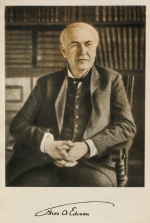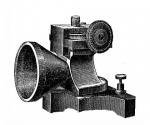Thomas Alva Edison


Thomas Alva Edison (February 11, 1847 – October 18, 1931) was an American inventor and businessman. He was the fourth most prolific inventor in history, holding 1,093 US patents in his name, as well as many patents in the United Kingdom, France, and Germany.
Theosophical involvement
On April 5, 1878, Edison sends in his signed application for Fellowship in the Theosophical Society, becoming a member of the latter in New Jersey.[1] On December 13 of that year, Col. Olcott went to Menlo Park, to see Edison about phonograph.
In October 1882 Master K.H. wrote to A. P. Sinnett that Edison was "a good deal protected by M."[2]
Although at least some of his views agreed with the Theosophical teachings, he was never very active in Society. As H. P. Blavatsky wrote in 1890:
Mr. Edison is a Theosophist, though not a very active one. Still, the very fact of his holding a diploma seems to inspire him with Theosophical truths.[3]
In the quote above she was referring to Edison's view of matter, which was against the current scientific view but in tune with the Theosophical one. Mme. Blavatsky quoted him as follows:
I do not believe that matter is inert, acted upon by an outside force. To me it seems that every atom is possessed by a certain amount of primitive intelligence: look at the thousand ways in which atoms of hydrogen combine with those of other elements. . . . . . Do you mean to say they do this without intelligence?[4]
Tasimeter

When discussing with A. P. Sinnett about undiscovered planets in the Solar System, Master K.H. mentions one of Edison's invention, the tasimeter, which was designed to measure infrared radiation:
Edison's tasimeter adjusted to its utmost degree of sensitiveness and attached to a large telescope may be of great use when perfected. When so attached the "tasimeter" will afford the possibility not only to measure the heat of the remotest of visible stars, but to detect by their invisible radiations stars that are unseen and otherwise undetectable, hence planets also. . . . His tasimeter, he says, "is affected by a wider range of etheric undulations than the eye can take cognizance of." Science will hear sounds from certain planets before she sees them. This is a prophecy. Unfortunately I am not a Planet, — not even a "planetary." Otherwise I would advise you to get a tasimeter from him and thus avoid me the trouble of writing to you.[5]
In 1931 Karl Jansky built the first radio telescope, and five years later, amateur astronomer Grote Reber applied this technique in the first application of a new branch of astronomy that became known as radio astronomy.[6] Thus, the Master's prophecy was fulfilled about 50 years later. However, Edison was the first scientist on record to have proposed an experiment to detect radio waves from the Sun, in 1890.[7]
Notes
- ↑ Henry Steel Olcott, Old Diary Leaves First Series (Adyar, Madras: The Theosophical Publishing House, 1974), 466.
- ↑ Vicente Hao Chin, Jr., The Mahatma Letters to A.P. Sinnett in chronological sequence No. 93b (Quezon City: Theosophical Publishing House, 1993), 325.
- ↑ Helena Petrovna Blavatsky, Collected Writings vol. XII (Wheaton, IL: Theosophical Publishing House, 1980), 130.
- ↑ Helena Petrovna Blavatsky, Collected Writings vol. XII (Wheaton, IL: Theosophical Publishing House, 1980), 130.
- ↑ Vicente Hao Chin, Jr., The Mahatma Letters to A.P. Sinnett in chronological sequence No. 93b (Quezon City: Theosophical Publishing House, 1993), 325.
- ↑ That Time Thomas Edison Almost Invented the Radio Telescope at io9.com
- ↑ Pre-History of Radio Astronomy at National Radio Astronomy Observatory